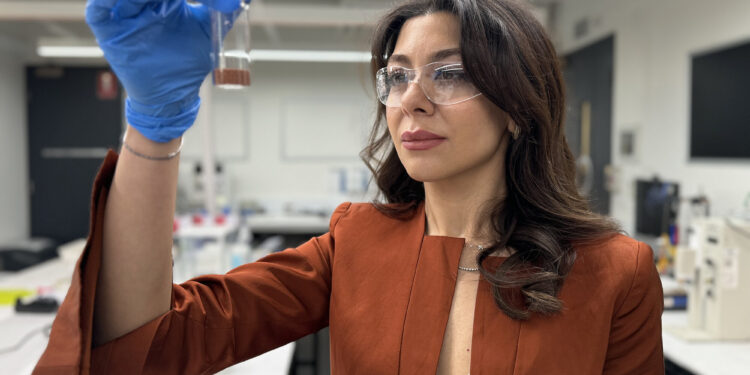RMIT University’s Dr Karma Zuraiqi holds a vial of copper, a key component of the team’s new catalyst. Credit: Michael Quin, RMIT
A new method of producing ammonia, harnessing the unique power of the liquid metal, could lead to significant reductions in the carbon emissions caused by the production of this widely used chemical.
Ammonia is used in fertilizers to grow much of our food, but also plays a role in clean energy as a vehicle for safely transporting hydrogen.
However, global ammonia production comes at a high environmental cost: it consumes more than 2% of global energy and produces up to 2% of global carbon emissions.
Dr Karma Zuraiqi, a researcher at RMIT and lead author of a study on the topic, said her team’s greener alternative used 20 per cent less heat and 98 per cent less pressure than the centuries-old Haber-Bosch process used today to separate nitrogen and hydrogen into ammonia.
The work appears in Catalysis of nature .
“Global ammonia production currently accounts for twice as many emissions as Australia. If we can improve this process and make it less energy intensive, we can significantly reduce carbon emissions,” said Zuraiqi, from the RMIT School of Engineering.
The study results show that the low-energy approach is as efficient in producing ammonia as the current gold standard by relying more on efficient liquid metal catalysts and less on pressure force.
“The copper and gallium we use are also much cheaper and more abundant than ruthenium, a precious metal used as a catalyst in current approaches,” Zuraiqi said. “All of these advantages make this an exciting new development that we look forward to exploring further and testing outside the lab.”
Liquid metal to the rescue
The team, which includes RMIT’s Professor Torben Daeneke, is at the forefront of exploiting the special properties of liquid metal catalysts for ammonia production, carbon capture and energy production.
A catalyst is a substance that allows chemical reactions to occur more quickly and easily without being consumed itself.
This latest study showcased their new technique by creating tiny droplets of liquid metal containing copper and gallium – called “nanoplanets” because of their hard crust, liquid outer core and solid inner structure – as a catalyst to break down the raw ingredients of nitrogen and hydrogen.
“Liquid metals allow us to move chemical elements more dynamically, which allows us to bring everything to the interface and get more efficient reactions, which are ideal for catalysis,” Daeneke said. “Copper and gallium separately have both been considered poor catalysts for ammonia production, but together they do the job extremely well.”
Tests revealed that gallium decomposed nitrogen, while the presence of copper aided in the separation of hydrogen, combining to work as effectively as current approaches at a fraction of the cost.
“We basically found a way to take advantage of the synergy between the two metals, increasing their individual activity,” Daeneke said.
RMIT is now leading the commercialisation of this technology, which is jointly owned by RMIT and QUT.
Scaling for industry
Although ammonia produced via the traditional Haber-Bosch process is only viable in large-scale installations, the team’s alternative approach could be suitable for both large-scale production and smaller-scale decentralized production, where small quantities are made more cheaply on solar farms, which in turn would reduce transportation costs and emissions.
Besides the obvious applications in ammonia production for fertilizers, this technology could be a key enabler for the hydrogen industry and support the move away from fossil fuels.
“A good way to make hydrogen safer and easier to transport is to convert it into ammonia,” Daeneke explained. “But if we use ammonia produced by current techniques as a hydrogen carrier, the emissions from the hydrogen industry could significantly increase global emissions. Our vision is to combine our green ammonia production technology with hydrogen technologies, which would allow green energy to be transported safely around the world without huge losses along the way,” he said.
The next challenges are to improve the technology, which has so far been proven in the laboratory, and to design the system to operate at even lower pressures, making it more practical as a decentralized tool for a wider range of industries.
“At this stage, we are really excited about the results and we look forward to talking to potential partners interested in extending this project to their sector,” he said.
More information:
Unveiling of metal mobility in a Cu–Ga liquid catalyst for ammonia synthesis, Catalysis of nature (2024). DOI: 10.1038/s41929-024-01219-z
Provided by RMIT University
Quote:Low-carbon ammonia offers green alternative for agriculture and hydrogen transportation (2024, September 19) retrieved September 19, 2024 from
This document is subject to copyright. Apart from any fair dealing for the purpose of private study or research, no part may be reproduced without written permission. The content is provided for informational purposes only.



